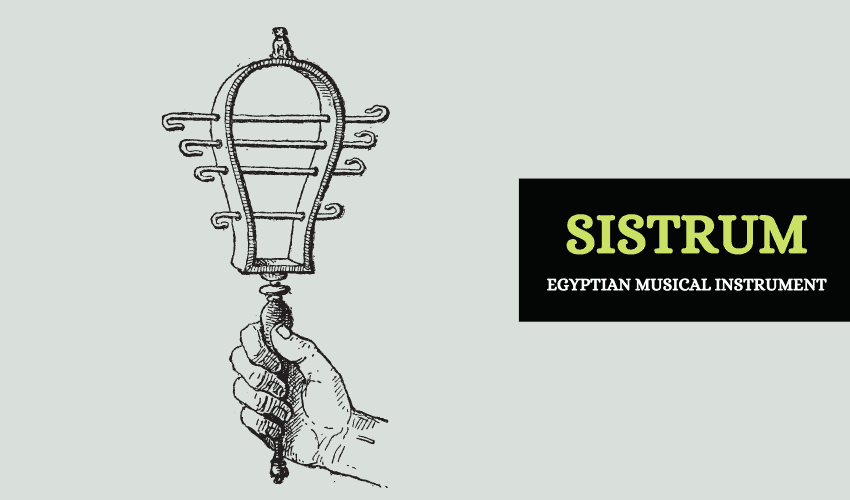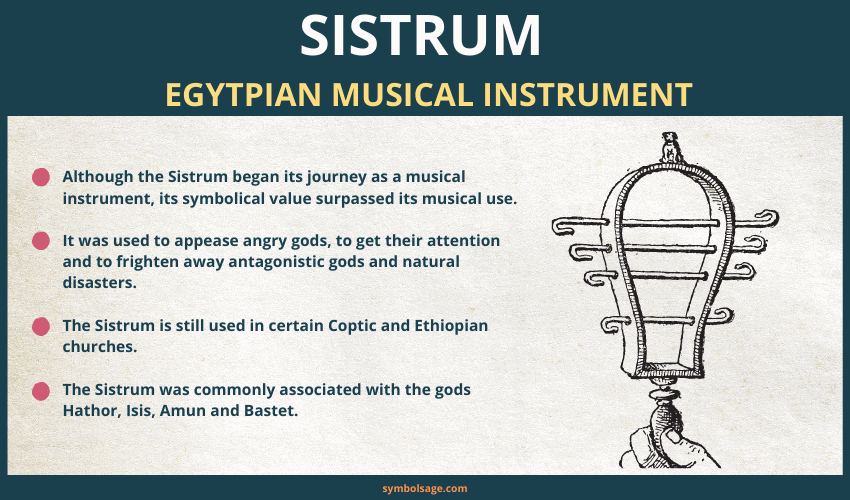
Table of Contents
Among the many symbols of Ancient Egypt, the Sistrum (rattle) was a musical instrument with an essential role. Although it first appeared related to music, its symbolism and mystical purposes grew beyond that. Here’s a closer look at the Sistrum.
What was the Sistrum?
The Sistrum (plural Sistra) was a musical percussion instrument, somewhat like a rattle, that was used by the ancient Egyptians in various rites and ceremonies. The Sistrum first appeared in the Old Kingdom and became connected with the goddesses Isis and Hathor. It’s closes modern equivalent is the tambourine.
This instrument resembled a rattle, and it was used in the same way. The Sistrum had a long handle, a frame with crossbars, and small disks that rattled when shaken. The instrument was made using wood, stone, or metal. The word Sistrum means that which is being shaken.
Types of Sistra
The oldest Sistrum, also known as Naos-sistrum, appeared in the Old Kingdom and had strong associations with Hathor. These Sistra had cow horns and the face of Hathor depicted on the handles. In some cases, the instrument also had falcons on the top. These Sistra were sophisticated items with several depictions and details. Unfortunately, this variety of Sistra have survived mainly in artworks and portrayals, with very few actual ancient Sistra in existence.
Most of the surviving Sistra come from the Greco-Roman era. These items had fewer details and a different shape. They had only a loop-shaped frame and a long handle in the form of a papyrus stem.
The Role of the Sistrum in Ancient Egypt
The associations of the Sistrum with the goddess Hathor also connected it with the powers of the goddess. For instance, the Sistrum became a symbol of joy, festivity, and erotism since these were traits of Hathor. Besides this, the Egyptians believed that the Sistrum had magical properties. Some sources believe that the Sistrum could derive from another symbol of Hathor, the Papyrus plant. One of the most famous depictions of the Sistrum is in the Hathor temple in Dendera.
In the beginning, the Sistrum was an instrument and symbol that only the gods and the high priests and priestesses of Egypt could carry. Its power was such that these mighty beings used it to frighten Set, the god of chaos, the desert, storms, and disaster. In addition to this, it was believed that the Sistrum could also avert the flooding of the Nile. With these two fundamental functions, this instrument became associated with the goddess Isis. In some of her depictions, Isis appears with a symbol of the inundation in one hand, and with the Sistrum in the other.

The Symbolism of the Sistrum
Although the Sistrum began its journey as a musical instrument, its symbolical value surpassed its musical use. The Sistrum became a central part of a variety of rituals and ceremonies. It was also one of the items of the funerary and tomb equipment. In these cases, the Sistrum was non-functional and served as a symbol. The Sistrum was also a symbol of joy, erotism, and fertility.
Over time, the Sistrum was connected to the Papyrus plant, which were significant symbols of the goddess Hathor, and of Lower Egypt. Some myths propose that Hathor emerged from a papyrus plant. Other sources tell the story of Isis hiding her son, Horus, in the papyrus thicket surrounding the Nile. For its associations with the papyrus, the Sistrum also became a symbol of the deities Amun and Bastet.
In later times, the Sistrum became a symbol the Egyptians used to appease the wrath of Hathor.
By the time of the New Kingdom, the Sistrum was the instrument that pacified Hathor and any other deity perceived to be enraged.
The Sistrum in the Greco-Roman Period
When the Romans invaded Egypt, the cultures and mythologies of these two regions mixed. Isis became one of the most worshipped deities during this era and her symbols survived with her. Every time the frontiers of the Roman Empire stretched, the worship and symbolism of the Sistrum did too. The Sistrum maintained its importance during this period until the appearance of Christianity.
Due to this spread of the Sistrum, this symbol is still present nowadays as a fundamental part of worship and religion in several regions of Africa. In Coptic and Ethiopian churches, the Sistrum remains a powerful symbol.
In Brief
While the Sistrum started out as a musical instrument, it became important as a symbolic item in religious contexts. Even today, it continues to be used in certain Christian churches and is sometimes still used in musical contexts.








